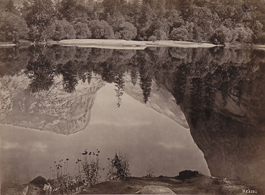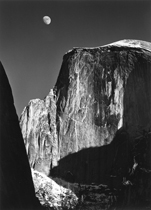home | metro silicon valley index | the arts | visual arts | preview

Cantor Arts Center, Gift from the Alinder Collection, 1991.213
Sierra high: 'The Domes, from the Sentinel Dome, Yosemite National Park,' an albumen print, 1865-66, by Carleton E. Watkins. (Click here to see a full-size version of the above image.)
Valley High
The Cantor Arts Center at Stanford focuses on Yosemite in the matchless images of four photographers
By Michael S. Gant
RECENTLY, people have been falling off the backside approach to Half Dome with alarming frequency. A news photograph of a typical day on the exposed granite slope showed a mass of amateur hikers clutching the cable hand-holds in numbers seen only at Harry Potter book-release parties. Ever since the first nonnative Americans arrived in Yosemite Valley in the 1850s, its vistas have evoked feelings of awe--not to mention inspired legions of campers and gawkers. Clearly, judging from the traffic jams on Half Dome, we have loved Yosemite well but perhaps not wisely.
San Francisco.com Real Estate
Moving to the Bay Area just became easy. Let San Francisco.com show you all the homes currently for sale.
San Jose.com Real Estate
Relocating to San Jose or Silicon Valley? Let San Jose.com introduce you to some expert area real estate agents.
Yosemite's wonders stormed the public's consciousness in the form of grandiose landscape paintings by Albert Bierstadt and Thomas Hill, as well as in portable and easily dispersed photographs. A new show at Stanford's Cantor Arts Center, "Yosemite's Structure and Textures," displays the works of three 19th-century photographers and the most familiar of all Yosemite chroniclers: Ansel Adams.
Carleton E. Watkins first visited Yosemite in the 1860s, toting a mammoth-plate camera capable of taking 18-by-22-inch negatives. The wet-plate collodion process of the era involved a noxious soup of chemicals that needed to be arduously applied on the spot. The negatives were then processed as albumen prints, imparting that light amber tone that enhances their air of nostalgia. Despite the technical obstacles, Watkins produced stunning images capturing the splendor of El Capitan, Cathedral Rocks and the Sentinel Domes. The scale of his negatives allows for an extraordinary range of detail across panoramic distances.

From the Elizabeth K. Raymond Fund
Reflective: 'Mirror Lake, Yosemite, 1867,' an albumen print by Eadweard Muybridge. (Full-size version)
In Mirror View of El Capitan, a line of trees perfectly divides the monolith itself from its crystalline double in the water of the Merced River. But Watkins avoids rote symmetry by foregrounding a felled tree jutting across the lower-left corner, weighting the image. In The Yosemite Falls, 2630 Ft., two pairs of darkly silhouetted trees provide an archway through which the torrent of the falls is glimpsed in the distance.
Eadweard Muybridge, noted for his early studies in motion photography and his tabloid personal life (he was acquitted of gunning down his wife's lover in a trial that Court TV could only dream about), followed Watkins into Yosemite, often setting his camera up in the same location. Muybridge, too, took mammoth-plate photographs, but he is represented in the show with smaller (about 6-by-8-inch images), which puts him at a bit of a disadvantage next to Watkins. His portrait of the Three Brothers rock formation almost duplicates that of Watkins but looks less dramatic, a little flatter.
Muybridge often reveled in the effects that long exposures could produce, especially the play of rushing water. The tactic woks spectacularly well in his print The First Fall, in which a flume grows into a gauzy, dancing torrent. A better businessman than Watkins, Muybridge also took stereo views that could be sold cheaply to satisfy the craze for 3-D images.

© 2007 The Ansel Adams Publishing Rights Trust
Dome sweet dome: Ansel Adams' gelatin-silver print 'Moon and Half Dome, Yosemite Valley' captures the granite starkness of Yosemite. (Full-size version)
George Fiske, who lived and worked in the valley in the 1880s, domesticated the work of Watkins and Muybridge with his postcard-size views. His moody shot of El Capitan capped with storm clouds forms a bridge to the 20th-century work of Ansel Adams (who, in his youth, made prints from Fiske's negatives).
Fiske's instinct for atmospheric grandeur culminates in Adams' dramatic use of clouds shadowing mountains in Clearing Winter Storm and Thunder Clouds Over Unicorn. And no show about Yosemite image makers would be complete without Adams' iconic and severely beautiful Moon and Half Dome. This landscape shows us a Yosemite immemorial, a Yosemite unsullied by visitors who can't help but hasten the disintegration of what they come to marvel at. If, someday, we close Yosemite for its (and our) own good, at least we will have these images to remind us of what we must give up.
Yosemite's Structure and Textures runs Wednesday-Sunday, 11am-5pm and Thursday till 8pm through Oct. 28 at the Cantor Arts Center, Stanford University. Free. (650.723.4177)
Send a letter to the editor about this story.
|
|
|
|
|
|
